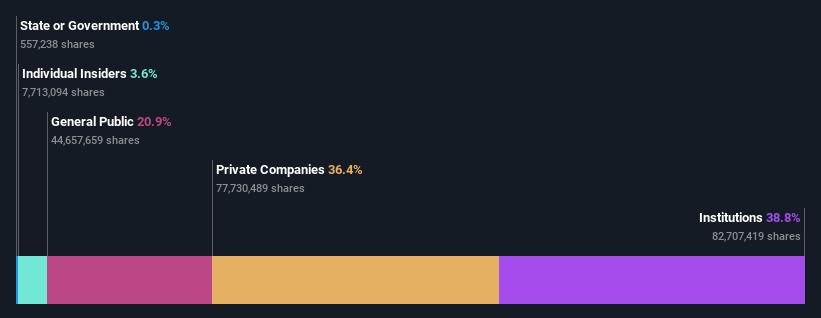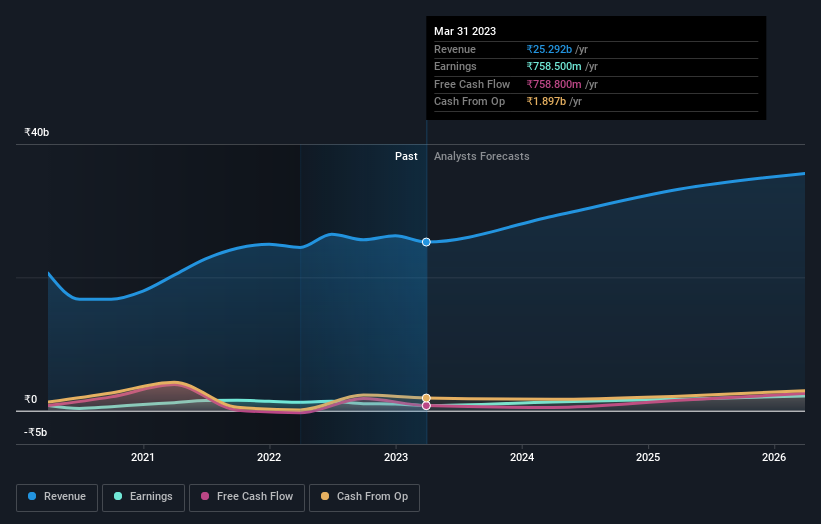- India
- /
- Consumer Durables
- /
- NSEI:ORIENTELEC
Positive week for Orient Electric Limited (NSE:ORIENTELEC) institutional investors who lost 13% over the past year

Key Insights
- Institutions' substantial holdings in Orient Electric implies that they have significant influence over the company's share price
- A total of 7 investors have a majority stake in the company with 53% ownership
- Insiders have sold recently
A look at the shareholders of Orient Electric Limited (NSE:ORIENTELEC) can tell us which group is most powerful. And the group that holds the biggest piece of the pie are institutions with 39% ownership. In other words, the group stands to gain the most (or lose the most) from their investment into the company.
Last week's ₹4.7b market cap gain would probably be appreciated by institutional investors, especially after a year of 13% losses.
In the chart below, we zoom in on the different ownership groups of Orient Electric.
View our latest analysis for Orient Electric

What Does The Institutional Ownership Tell Us About Orient Electric?
Institutions typically measure themselves against a benchmark when reporting to their own investors, so they often become more enthusiastic about a stock once it's included in a major index. We would expect most companies to have some institutions on the register, especially if they are growing.
We can see that Orient Electric does have institutional investors; and they hold a good portion of the company's stock. This implies the analysts working for those institutions have looked at the stock and they like it. But just like anyone else, they could be wrong. When multiple institutions own a stock, there's always a risk that they are in a 'crowded trade'. When such a trade goes wrong, multiple parties may compete to sell stock fast. This risk is higher in a company without a history of growth. You can see Orient Electric's historic earnings and revenue below, but keep in mind there's always more to the story.

Hedge funds don't have many shares in Orient Electric. Central India Industries Limited is currently the largest shareholder, with 25% of shares outstanding. For context, the second largest shareholder holds about 6.6% of the shares outstanding, followed by an ownership of 6.0% by the third-largest shareholder.
On further inspection, we found that more than half the company's shares are owned by the top 7 shareholders, suggesting that the interests of the larger shareholders are balanced out to an extent by the smaller ones.
While it makes sense to study institutional ownership data for a company, it also makes sense to study analyst sentiments to know which way the wind is blowing. There are plenty of analysts covering the stock, so it might be worth seeing what they are forecasting, too.
Insider Ownership Of Orient Electric
The definition of an insider can differ slightly between different countries, but members of the board of directors always count. Management ultimately answers to the board. However, it is not uncommon for managers to be executive board members, especially if they are a founder or the CEO.
Most consider insider ownership a positive because it can indicate the board is well aligned with other shareholders. However, on some occasions too much power is concentrated within this group.
We can see that insiders own shares in Orient Electric Limited. It has a market capitalization of just ₹51b, and insiders have ₹1.9b worth of shares, in their own names. This shows at least some alignment. You can click here to see if those insiders have been buying or selling.
General Public Ownership
The general public-- including retail investors -- own 21% stake in the company, and hence can't easily be ignored. While this size of ownership may not be enough to sway a policy decision in their favour, they can still make a collective impact on company policies.
Private Company Ownership
It seems that Private Companies own 36%, of the Orient Electric stock. Private companies may be related parties. Sometimes insiders have an interest in a public company through a holding in a private company, rather than in their own capacity as an individual. While it's hard to draw any broad stroke conclusions, it is worth noting as an area for further research.
Next Steps:
It's always worth thinking about the different groups who own shares in a company. But to understand Orient Electric better, we need to consider many other factors. Take risks for example - Orient Electric has 3 warning signs we think you should be aware of.
But ultimately it is the future, not the past, that will determine how well the owners of this business will do. Therefore we think it advisable to take a look at this free report showing whether analysts are predicting a brighter future.
NB: Figures in this article are calculated using data from the last twelve months, which refer to the 12-month period ending on the last date of the month the financial statement is dated. This may not be consistent with full year annual report figures.
New: AI Stock Screener & Alerts
Our new AI Stock Screener scans the market every day to uncover opportunities.
• Dividend Powerhouses (3%+ Yield)
• Undervalued Small Caps with Insider Buying
• High growth Tech and AI Companies
Or build your own from over 50 metrics.
Have feedback on this article? Concerned about the content? Get in touch with us directly. Alternatively, email editorial-team (at) simplywallst.com.
This article by Simply Wall St is general in nature. We provide commentary based on historical data and analyst forecasts only using an unbiased methodology and our articles are not intended to be financial advice. It does not constitute a recommendation to buy or sell any stock, and does not take account of your objectives, or your financial situation. We aim to bring you long-term focused analysis driven by fundamental data. Note that our analysis may not factor in the latest price-sensitive company announcements or qualitative material. Simply Wall St has no position in any stocks mentioned.
About NSEI:ORIENTELEC
Orient Electric
Manufactures, purchases, and sells electrical consumer durables, and lighting and switchgear products in India and internationally.
Flawless balance sheet with high growth potential.
Market Insights
Community Narratives



